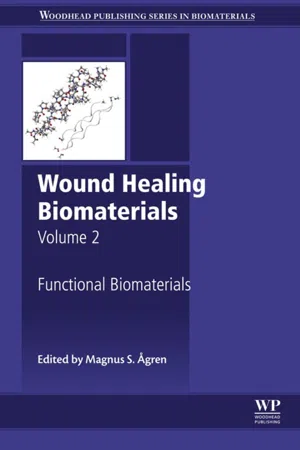
- 542 pages
- English
- ePUB (mobile friendly)
- Available on iOS & Android
About This Book
Wound Healing Biomaterials: Volume Two, Functional Biomaterials discusses the types of wounds associated with trauma, illness, or surgery that can sometimes be extremely complex and difficult to heal. Consequently, there is a prominent drive for scientists and clinicians to find methods to heal wounds opening up a new area of research in biomaterials and the ways they can be applied to the challenges associated with wound care.
Much research is now concerned with new therapies, regeneration methods, and the use of biomaterials that can assist in wound healing and alter healing responses. This book provides readers with a thorough review of the functional biomaterials used for wound healing, with chapters discussing the fundamentals of wound healing biomaterials, films for wound healing applications, polymer-based dressing for wound healing applications, and functional dressings for wound care.
- Includes more systematic and comprehensive coverage on the topic of wound care
- Provides thorough coverage of all specific therapies and biomaterials for wound healing
- Contains clear layout and organization that is carefully arranged with clear titles and comprehensive section headings
- Details specific sections on the fundamentals of wound healing biomaterials, films for wound healing applications, polymer-based dressing for wound healing applications, and more
Frequently asked questions
Information
Introduction to biomaterials for wound healing
Abstract
Keywords
Biomaterials; Nanofiber based; Polysaccharide based; Protein based; Wound healing1.1. Definition of biomaterial
1.2. Types of biomaterials
1.2.1. Synthetic biomaterials
1.2.1.1. Metals
1.2.1.2. Polymers
1.2.1.3. Ceramics
1.2.1.4. Composites
| Biomaterial | Advantages | Disadvantages | Examples |
| Metal | Strong, tough, and ductile | Corrodible, dense, and complicated to fabricate | Joint replacement, bone plates and screws, dental root implants, pacers, and sutures |
| Polymers | Resilient and easy to fabricate | Fragile, deformable, and degradable | Blood vessels; sutures; tissue engineering for ear, nose, and soft tissues |
| Ceramics | Very biocompatible, inert, and strong in compression | Difficult to fabricate, brittle, and not resilient | Dental coatings and orthopedic implants, such as femoral head of neck |
| Composites | Strong in compression | Difficult to fabricate | Joint implants, heart valves |
1.2.2. Natural biomaterials
Table of contents
- Cover image
- Title page
- Table of Contents
- Related titles
- Copyright
- List of contributors
- Woodhead Publishing Series in Biomaterials
- Part One. Fundamentals of wound healing biomaterials
- Part Two. Biomaterial films for wound healing
- Part Three. Polymer biomaterials and dressings for wound healing
- Part Four. Other functional biomaterial dressingsfor wound healing
- Index
